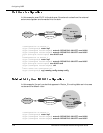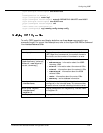
Configuring OSPF
Command Line Interface Protocol Configuration Guide 1-11
In this example, area 0.0.0.3 does not have a direct physical connection to the backbone
(area 0.0.0.0). To establish a backbone connection, a virtual link is configured between
Router_1 and Router_2. Area 0.0.0.1 is the transit area and Router_1 is the entry point
into area 0.0.0.0. Router_2 has a logical connection to the backbone through the transit
area.
!
Configuration on Router_2
Cajun (configure)#
router ospf
Cajun (configure router:ospf)#
network 172.11.0.0 0.0.0.255 area 0.0.0.1
Cajun (configure router:ospf)#
network 172.17.0.0 0.0.0.255 area 0.0.0.3
!
This command defines area 0.0.0.1 as the transit area and the router ID
!
of the other side of the virtual link is configured.
Cajun (configure router:ospf)#
area 1.0.0.0 virtual-link 15.5.6.3
!
!
Configuration on Router_1
Cajun (configure)#
router ospf
Cajun (configure router:ospf)#
network 11.10.0.0 0.0.0.255 area 0.0.0.0
Cajun (configure router:ospf)#
network 11.25.0.0 0.0.0.255 area 0.0.0.1
!
!
This command defines area 0.0.0.1 as the transit area and the router ID
!
of the other side of the virtual link is configured.
Cajun (configure router:ospf)#
area 0.0.0.1 virtual-link 15.15.22.0
Cajun (configure router:ospf)#
exit
!
!
This saves the configuration.
Cajun (configure)#
copy running-config startup-config
Area 0.0.0.1
Area 0.0.0.0
Area 0.0.0.3
Router_1
Router_2
Router ID
15.15.22.0
Router ID
15.5.6.3
ospf2.vsd


















